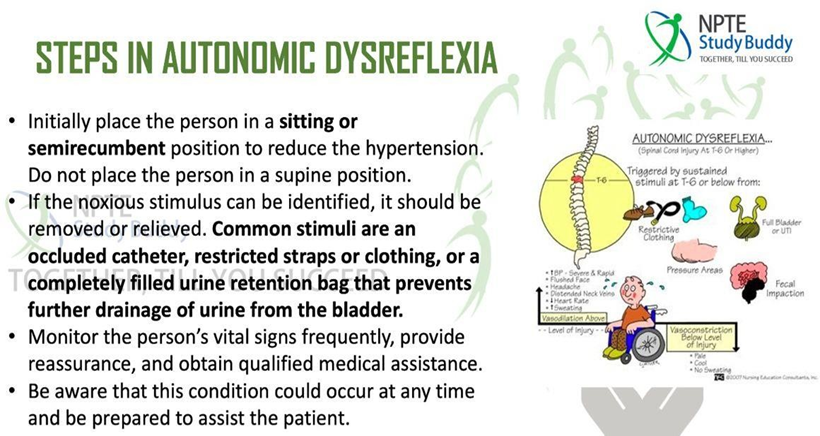A nurse is caring for a client who has a spinal cord injury and has developed autonomic dysreflexia. Identify the sequence of steps the nurse should take.
(Move the steps into the box on the right, placing them in the order of performance. Use all the steps.)
Administer an antihypertensive medication intravenously.
Confirm that the client's bladder is empty.
Indicate the risk for autonomic dysreflexia in the client's medical record.
Place the client in an upright sitting position.
The Correct Answer is D,B,A,C
Step D (Place the client in an upright sitting position): Elevating the client's head and upper body to an upright position helps to reduce blood pressure by promoting venous pooling in the lower extremities.
Step B (Confirm that the client's bladder is empty): Autonomic dysreflexia is often triggered by bladder distention or urinary retention. By confirming and addressing urinary issues promptly, the nurse can remove the triggering stimulus.
Step A (Administer an antihypertensive medication intravenously): In severe cases where blood pressure remains dangerously high despite other interventions, such as positioning and addressing bladder issues, antihypertensive medications may be necessary to lower blood pressure quickly and prevent complications.
Step C (Indicate the risk for autonomic dysreflexia in the client's medical record): Documentation of the occurrence of autonomic dysreflexia, its triggers, and interventions used is essential for continuity of care. It informs other healthcare providers about the client's condition and helps in implementing preventive strategies.

Nursing Test Bank
Naxlex Comprehensive Predictor Exams
Related Questions
Correct Answer is D
Explanation
D. A weight loss of 1.8 kg (4 lb) in the past 24 hours indicates effective diuresis (urine output) and reduction in fluid volume, which is the therapeutic goal of furosemide in treating pulmonary edema.
A Furosemide is a loop diuretic that typically causes a decrease in blood pressure by promoting the excretion of excess fluid and sodium from the body.
B. Adventitious breath sounds such as crackles (rales) indicate the presence of fluid in the lungs, which is a characteristic finding in pulmonary edema.
C. A respiratory rate of 24 breaths per minute is within normal range for an adult at rest. While this respiratory rate is not abnormal, it also does not directly indicate whether furosemide is effective in treating pulmonary edema.
Correct Answer is C
Explanation
C. A bed alarm is a device that triggers an alert when the client attempts to get out of bed or leaves a designated area. Bed alarms can be effective in alerting nursing staff to the client's movements, allowing for timely intervention to prevent wandering and ensure the client's safety. This intervention is commonly used in healthcare settings to monitor clients at risk for falls or wandering.
A Moving the client to a double room may not necessarily prevent wandering. In fact, it could potentially increase the risk if the client wanders into another resident's space or attempts to leave the room altogether.
B. Using chemical restraints (such as medications to sedate or calm the client) is not recommended unless absolutely necessary for the safety of the client or others. It does not address the underlying cause of wandering and can have significant adverse effects on the client's health and well-being.
D. Providing excessive stimulation can overwhelm and agitate clients with dementia, potentially worsening behaviors such as wandering. It is important to offer activities that are calming, engaging, and appropriate for the client's cognitive abilities.
Whether you are a student looking to ace your exams or a practicing nurse seeking to enhance your expertise , our nursing education contents will empower you with the confidence and competence to make a difference in the lives of patients and become a respected leader in the healthcare field.
Visit Naxlex, invest in your future and unlock endless possibilities with our unparalleled nursing education contents today
Report Wrong Answer on the Current Question
Do you disagree with the answer? If yes, what is your expected answer? Explain.
Kindly be descriptive with the issue you are facing.
